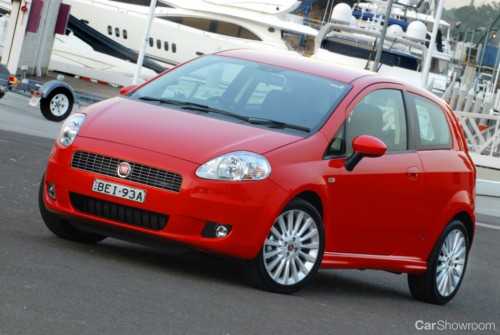The Fiat Punto is one of those cars that defies categorisation. According to the Australian automotive industry statistics (VFACTS), it belongs in the segment for light cars costing more than $25K. But it is comparable in size to many models in the next category up (‘small cars’) and some variants cost considerably less than $25,000. Furthermore, although this machine carries one of the most Italian automotive names, there is plenty of German influence on the overall design because at the time it was being developed, Fiat was in a collaborative arrangement with Opel making the Punto and Opel Corsa more than kissing cousins.
This is an especially striking car of crisp, integrated design, which stands out from the traffic and attracts plenty of positive comments. Significantly, the Punto (Grand Punto in most other markets) was designed by the same studio (Giugiaro) which created the original mid-1970s Volkswagen Golf. Rivals include the Corolla and the Volkswagens Golf and the Polo. Again, we see this new-century Fiat straddling light and small car sectors.
Three engines are offered in various combinations with five and six-speed manual transmissions and a five-speed automatic. The entry level Dynamic five-door hatch is priced at $19,990 and has the 57 kW 1.4-litre petrol engine with the five-speed manual. An extra four grand buys the same vehicle with the 66 kW turbodiesel engine running through a six-speed manual gearbox and this variant is our focus here. There are also Sport models in both manual and automatic guises, priced from $25,990 but with heavy discounts available at present.
The blend of performance and economy provided by this small and absolutely modern turbocharged diesel engine will astonish many prospective buyers once the tachometer needle has progressed past about 1800 rpm.
With an official fuel consumption figure of just 4.4 litres per 100 kilometres, the Dynamic diesel makes an outstanding case for itself as an environmentally responsible choice. Even the five-speed petrol version consumes just 5.9, but this does have to be 95-RON premium as a minimum. On carbon emissions, both do well with the diesel rated at 119 g/km and the petrol manual at 139.
Although the Punto Sport makes a certain appeal to enthusiast drivers, the less expensive variants are best understood as ultra-efficient modern cars with few vices. The electric steering is very light and, at sub-30 km/h speeds, can be rendered even lighter for parking by pushing a button. While it is not the kind of car one feels like hurling into corners, the Punto handles well and also has a supple ride. There is some road noise, but not an excessive amount.
The level of standard equipment is fantastic for the price. Electronic stability and traction control are included on all models, while the 1.9-litre Puntos also get ‘Hill Holder’ to help less experienced drivers take off uphill without rolling back. Smaller-engined vehicles come with a welcome full-size spare tyres but the 1.9-litre cars supply only a space-saver.
Speaking of space, there is heaps of inside and the seats are especially comfortable. You sit quite high with a commanding view down the short bonnet. The interior blends Italian pizzazz with German-type quality and finish. Unlike Fiats of the distant past, the controls are logically arranged. Even more importantly, the driving position suits people of all shapes and sizes, no longer favouring those with long arms and short legs. This interior feels more welcoming that one expects of an entry level light/small car. The Punto is as distinctive inside as it is outside.
This new age Fiat has been awarded five stars in the demanding Euro-NCAP testing, which is another big point in its favour.
Wisely, the Australian Fiat agent waited until the right cars were available before embarking on the challenge of reintroducing the marque locally. The Punto came first and was followed by the larger Ritmo and the impossibly cute 500. After the embarrassing Croma and dull Regata of the 1980s, all three are welcome. In the context of their time, these new Fiats do not stand out quite as much as the best of the much-loved 1960s models, but you can rest assured that they will not rust, are very much better made and, while less sporting in character, will prove a much better long-term ownership proposition.
Thumbs-up:
Exterior styling, interior flair, 4.4 litres per 100 km diesel economy
Thumbs-down:
Dubious resale value, ‘invisible’ in crowded new car market













